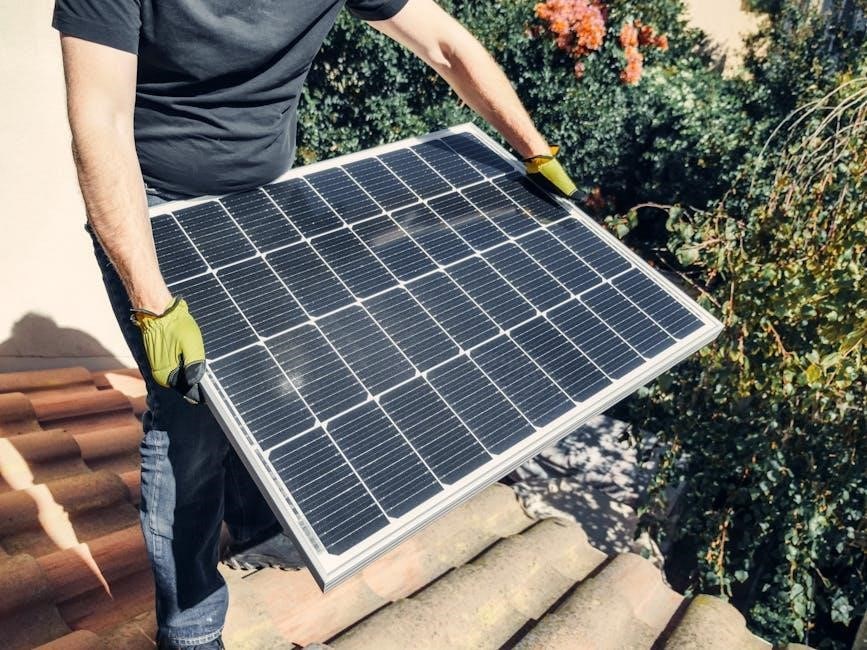A solar oven is a device that captures the sun’s heat for cooking, offering a hands-on way to explore renewable energy and heat transfer principles.
1.1 What is a Solar Oven?
A solar oven is a device that captures sunlight and converts it into heat for cooking. It uses reflective surfaces to direct sunlight onto an insulated container, trapping heat and cooking food. Made from materials like cardboard, aluminum foil, and plastic, solar ovens are eco-friendly, cost-effective, and promote renewable energy use. They are often used in science projects to teach students about heat transfer, insulation, and sustainable energy solutions.
1.2 Importance of Solar Oven Projects in Education
Solar oven projects are valuable educational tools that teach students about renewable energy, heat transfer, and environmental sustainability. They encourage hands-on learning, fostering creativity and problem-solving skills. These projects also promote STEM education by integrating science, technology, engineering, and math concepts. Additionally, they raise awareness about global energy challenges and inspire students to explore innovative solutions for a sustainable future.

Core Concepts of Solar Ovens
Solar ovens rely on capturing sunlight, converting it into heat, and retaining it through insulation and reflective surfaces, demonstrating principles of energy transformation and thermal management.
2.1 How Solar Ovens Work
Solar ovens function by capturing sunlight, converting it into heat, and retaining it through insulation. Reflective surfaces direct sunlight onto an absorptive surface, often dark-colored, which heats up. This heat is trapped inside the oven, often aided by glass or plastic covers that allow light in but prevent heat from escaping. Insulation materials like foam or fabric further reduce heat loss, enabling the oven to reach high temperatures for cooking. Airflow is controlled to maintain consistent heat levels.
2.2 Principles of Solar Energy and Heat Transfer
Solar energy is harnessed through the absorption of sunlight, which is converted into heat. Heat transfer occurs via conduction, convection, and radiation. Conduction involves direct heat flow through materials, while convection relies on fluid movement. Radiation transfers heat via electromagnetic waves. In solar ovens, these principles work together to absorb, retain, and distribute heat efficiently, enabling cooking without traditional fuel sources. Insulation and reflective materials enhance these processes to maximize energy capture and retention.
2.3 Role of Insulation and Reflection in Solar Ovens
Insulation traps heat inside the oven, reducing heat loss and maintaining high temperatures. Reflective surfaces, like aluminum foil or mirrors, direct sunlight into the oven, increasing heat absorption. Together, these elements enhance efficiency by focusing solar energy and retaining it, ensuring consistent cooking temperatures; Proper insulation and reflection are critical for optimizing performance and achieving successful solar cooking outcomes.

Design and Construction of a Solar Oven
Designing and building a solar oven involves creativity and practicality. It requires balancing heat absorption, insulation, and reflection to maximize efficiency. Students learn to engineer a functional, eco-friendly cooker using everyday materials, fostering innovation and sustainability awareness. This hands-on project teaches the importance of precise measurements and structural integrity while promoting renewable energy concepts in a fun, educational way.
3.1 Materials Needed for Building a Solar Oven
To construct a solar oven, essential materials include a sturdy cardboard box, aluminum foil, plastic wrap, scissors, glue, tape, a dark-colored container, and a clear plastic lid. Additional items like insulating foam, reflective paint, or a thermometer can enhance performance. These readily available materials make the project accessible and budget-friendly, allowing students to experiment with renewable energy concepts while learning about resourcefulness and sustainability in design.
3.2 Step-by-Step Guide to Constructing a Solar Oven
Start by cutting a rectangular hole in the top of the cardboard box, leaving a 1-inch border. Line the inside with aluminum foil for reflection. Create an insulating layer using crumpled paper or foam. Place a dark-colored container inside for heat absorption. Cover the hole with plastic wrap, securing it with tape. Angle the box toward the sun and test its efficiency. Ensure all materials are properly sealed for maximum heat retention.
3.3 Tips for Optimizing Your Solar Oven Design
Enhance efficiency by angling the oven to face direct sunlight. Use reflective materials like aluminum foil or mirrors to maximize solar absorption. Ensure proper insulation with thick, heat-retentive materials. Optimize ventilation for consistent airflow without heat loss. Experiment with dark, heat-absorbing surfaces inside. Regularly adjust the oven’s position to track the sun’s movement. These adjustments can significantly improve cooking performance and temperature retention.

Scientific Principles Behind Solar Ovens
Solar ovens rely on heat transfer, the greenhouse effect, and solar radiation to cook food efficiently using sunlight as the primary energy source.
4.1 Understanding Heat Transfer: Conduction, Convection, and Radiation
Solar ovens function by utilizing three primary forms of heat transfer: conduction, convection, and radiation. Conduction occurs through direct contact, such as heat moving from the oven’s base to the cooking surface. Convection involves the movement of heated air, which circulates inside the oven to distribute warmth evenly. Radiation is the absorption of sunlight by dark surfaces, converting light into heat. These principles work together to trap and retain heat, enabling efficient solar cooking.
4.2 The Greenhouse Effect and Its Role in Solar Ovens
The greenhouse effect occurs when sunlight enters a solar oven, heating its interior, while the structure traps this heat, preventing it from escaping. This natural phenomenon is enhanced by materials like glass or plastic, which allow sunlight in but retain heat. In solar ovens, this effect is crucial for maintaining high temperatures, enabling effective cooking by capturing and storing thermal energy efficiently.
4.3 The Importance of Angle and Positioning for Maximum Efficiency
The angle and positioning of a solar oven significantly impact its performance. Direct sunlight exposure maximizes energy absorption. The oven should face the sun directly, ideally at an angle equal to the location’s latitude. Adjusting the oven throughout the day ensures consistent sunlight capture. Incorrect positioning reduces efficiency, so precise alignment and periodic adjustments are essential for optimal cooking results and temperature maintenance.

Testing and Performance Evaluation
Testing evaluates the oven’s efficiency, measuring temperature, cooking time, and energy absorption. Comparative analysis with expectations helps identify improvements, ensuring optimal performance and functionality under various conditions.
5.1 How to Test the Efficiency of Your Solar Oven
To test the efficiency of your solar oven, start by measuring its ability to convert sunlight into heat. Place a thermometer inside the oven to monitor internal temperatures over time, comparing them to ambient temperatures. Assess how quickly the oven reaches a specific temperature and how well it retains heat. Conduct cooking tests, such as boiling water or cooking an egg, to evaluate performance. Additionally, observe how the oven’s angle and orientation affect heat capture. Testing under controlled conditions, such as clear skies and minimal wind, will provide more accurate results. Documenting temperature readings and cooking times will help analyze efficiency and identify areas for improvement. Finally, consider the environmental conditions, like cloud cover, that might influence the results. By systematically evaluating these factors, you can determine the oven’s efficiency and make necessary adjustments for optimal performance.
5.2 Measuring Temperature and Cooking Performance
To measure temperature, use thermometers to track internal and external oven temperatures. Place one inside the oven and another outside to compare. Record temperature changes over time to assess heat retention. For cooking performance, measure how long it takes to boil water or cook food. Compare these times to traditional cooking methods to evaluate efficiency. Ensure consistent sunlight and minimal external interference for accurate results. Documenting these measurements helps analyze the oven’s effectiveness and identify improvements.

5.3 Analyzing Results and Identifying Areas for Improvement
Analyze your solar oven’s performance by comparing temperature readings and cooking times. Identify inconsistencies or inefficiencies, such as uneven heating or slow cooking. Assess the effectiveness of insulation, reflectors, and angles. Use the data to refine your design, experimenting with materials or configurations to enhance performance. Document findings to guide future improvements, ensuring your solar oven operates at its maximum potential for optimal results.

Safety Considerations and Precautions
Handle hot surfaces with care to avoid burns. Use protective gear like gloves and goggles when cutting materials. Ensure proper ventilation to prevent inhaling fumes during construction.
6.1 Handling Hot Surfaces and Avoiding Burns
Always use oven mitts or tongs to handle hot surfaces or cooked items. Avoid direct contact with heated components to prevent burns. Keep a safe distance while adjusting or moving the solar oven. Ensure children are supervised when interacting with the oven. Regularly inspect for damaged insulation or reflective surfaces that may cause unexpected heat exposure. Prioritize caution to maintain a safe and enjoyable cooking experience with your solar oven.
6.2 Using Protective Gear When Working with Sharp Objects
When working with sharp objects, such as utility knives or scissors, always wear protective gloves and safety goggles. This gear shields hands from cuts and eyes from debris. Ensure gloves fit snugly and goggles are securely placed. Use sharp tools on stable surfaces, away from body parts. Supervise minors closely to prevent accidents. Prioritizing protective gear ensures a safe environment while building and maintaining your solar oven.

6.3 Ensuring Proper Ventilation During Cooking
Proper ventilation is crucial for safe and efficient solar cooking. It helps release steam, preventing overheating and ensuring even cooking. To achieve this, ensure small openings or vents are included in your solar oven design. This allows air to circulate while retaining heat. Regularly monitor the oven’s temperature and adjust the ventilation as needed to maintain optimal cooking conditions and prevent moisture buildup.
Educational Value of Solar Oven Projects
Solar oven projects offer a hands-on learning experience, fostering critical thinking, creativity, and problem-solving skills while connecting to STEM concepts and environmental sustainability.
7.1 Learning About Renewable Energy Sources
Solar oven projects introduce students to renewable energy by demonstrating how sunlight can be harnessed for cooking. This hands-on approach teaches the conversion of solar radiation into heat energy, highlighting its potential to reduce reliance on fossil fuels. By building and testing solar ovens, learners gain insights into sustainable energy solutions and their environmental benefits, fostering awareness of renewable resources and their practical applications.
7.2 Understanding the Engineering Design Process
Building a solar oven teaches the engineering design process, from defining a problem to testing solutions. Students learn to brainstorm ideas, create prototypes, and refine designs based on performance. This hands-on approach fosters critical thinking and problem-solving skills, emphasizing the importance of iteration and data analysis to achieve optimal results. It encourages creativity and resilience, key components of engineering practices.
7.3 Developing Problem-Solving and Critical Thinking Skills
Constructing a solar oven enhances problem-solving and critical thinking skills by challenging students to optimize design and functionality. It encourages analytical thinking through troubleshooting and refining prototypes. Students learn to evaluate data, interpret results, and make informed decisions to improve performance. This hands-on experience fosters creativity, adaptability, and logical reasoning, preparing them to tackle complex challenges in science and engineering with confidence and innovation.

Advanced Modifications and Innovations
Exploring advanced materials and designs, such as reflective surfaces or parabolic troughs, enhances solar oven efficiency and performance, pushing the boundaries of renewable energy applications.
8.1 Incorporating Reflective Materials for Better Efficiency
Incorporating reflective materials, such as aluminum foil or mirrors, enhances solar oven efficiency by redirecting sunlight into the cooking area. These materials increase heat absorption and retention, allowing the oven to reach higher temperatures. Proper angling of reflective surfaces is crucial to maximize sunlight capture. Experimenting with different materials and configurations can optimize performance, ensuring efficient solar cooking while maintaining safety and durability.
8.2 Using Different Insulating Materials to Retain Heat
Effective insulation is crucial for retaining heat in solar ovens. Materials like foam, newspaper, or straw can be used to line the oven, reducing heat loss. Experimenting with various insulating layers helps determine which materials provide the best thermal retention. Proper insulation ensures consistent cooking temperatures, improving efficiency and cooking performance while minimizing energy loss during the cooking process.
8.3 Exploring Parabolic Designs for Higher Temperatures
Parabolic solar oven designs use a curved surface to focus sunlight onto a specific point, significantly increasing temperatures. This shape concentrates solar rays, enhancing heat absorption and retention. Parabolic designs often achieve higher cooking temperatures compared to flat designs, making them ideal for frying and baking. However, they require precise alignment with the sun and can be more complex to construct, balancing higher efficiency with added complexity in design and operation.

Environmental Impact and Sustainability
Solar ovens reduce carbon emissions by harnessing renewable energy, decrease deforestation by minimizing firewood use, and lower greenhouse gases, promoting eco-friendly cooking and sustainability practices.
9.1 Reducing Carbon Footprint with Solar Cooking
Solar cooking significantly reduces carbon emissions by eliminating the need for fossil fuels. Unlike traditional stoves, solar ovens harness renewable sunlight, minimizing greenhouse gas production. This eco-friendly approach lowers carbon footprints, supports energy conservation, and aids in mitigating climate change. By adopting solar ovens, communities can reduce reliance on non-renewable resources, promoting sustainable living and environmental preservation. This shift fosters a greener future, aligning with global climate goals.
9.2 Promoting Energy Conservation Through Solar Ovens
Solar ovens promote energy conservation by utilizing sunlight as a renewable energy source, reducing reliance on electricity and fuel. They encourage sustainable practices and inspire innovation in energy-efficient technologies. By providing an eco-friendly cooking solution, solar ovens support conservation efforts and contribute to a culture of energy awareness and sustainability.
9.3 The Role of Solar Ovens in Addressing Global Energy Challenges
Solar ovens play a significant role in tackling global energy challenges by reducing reliance on fossil fuels and lowering carbon emissions. They provide a sustainable cooking solution, especially in regions with limited energy access. By promoting renewable energy use, solar ovens help mitigate climate change and support energy independence, making them a vital tool in addressing global energy demands and environmental sustainability.
Solar ovens offer a sustainable, eco-friendly solution for cooking, promoting renewable energy use and reducing carbon emissions. Their potential to address global energy challenges is immense, inspiring further innovation and adoption worldwide.
10.1 Summary of Key Concepts and Takeaways
A solar oven harnesses renewable energy to cook food using sunlight, demonstrating principles of heat transfer and insulation. It promotes sustainability, reduces carbon footprints, and offers practical solutions for eco-friendly cooking. Building a solar oven teaches engineering design, environmental stewardship, and resourcefulness. This project inspires creativity while addressing global energy challenges, proving solar cooking’s potential for a greener future. It’s an innovative, hands-on learning experience with real-world applications.
10.2 Potential Applications of Solar Oven Technology
Solar oven technology can be applied in various settings, from outdoor activities like camping to communities with limited access to electricity. It offers a sustainable cooking solution, reducing reliance on fossil fuels. Additionally, solar ovens can be used in emergency situations or for educational purposes, teaching renewable energy concepts. Their portability and efficiency make them ideal for eco-friendly initiatives, promoting environmental conservation and energy independence worldwide.
10.3 Encouraging Further Exploration and Innovation
Encouraging further exploration and innovation in solar oven technology can lead to more efficient designs and broader applications. Students and researchers can experiment with new materials and engineering techniques to improve performance. Community-based projects can inspire creativity and sustainability awareness. Competitions and collaborative initiatives can also drive advancements, fostering a culture of innovation and practical problem-solving for a greener future.

